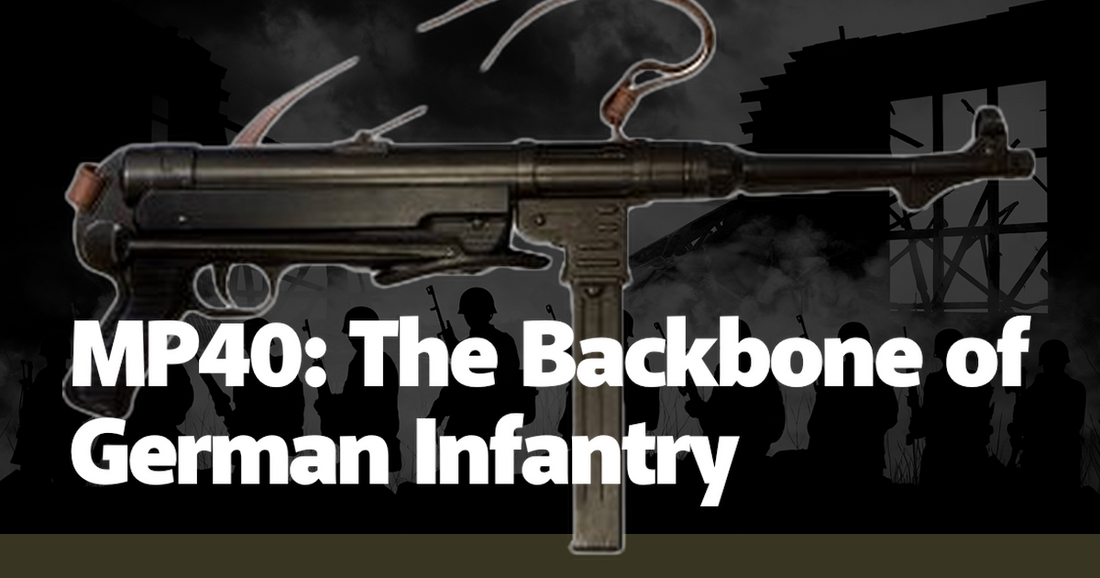The MP40, often referred to as the Maschinenpistole 40, stands as one of the most iconic firearms of World War II, embodying the engineering prowess and tactical foresight of the German military. Developed in 1938 by Heinrich Vollmer, the MP40 was designed to meet the Wehrmacht's demand for a compact, reliable submachine gun that could deliver high rates of fire in close-quarters combat. Unlike its predecessors, the MP40 utilized stamped steel parts, which made it simpler and cheaper to produce, a critical factor as the war escalated and resources became increasingly scarce. The weapon's construction allowed for mass production without sacrificing quality, making it a staple in the German infantry's arsenal.
One of the most striking features of the MP40 was its ease of use. With a rate of fire of around 500 to 550 rounds per minute, it struck a balance between controllability and lethality. This was particularly advantageous in urban warfare scenarios, such as the Battle of Stalingrad, where German soldiers often found themselves engaged in brutal, house-to-house fighting. The MP40's compact size and folding stock made it ideal for these environments, allowing soldiers to maneuver through tight spaces and deliver rapid bursts of fire. Veterans of the Eastern Front often recounted how the MP40's reliability in harsh conditions, from the frozen steppes of Russia to the muddy fields of Ukraine, provided a psychological edge over their adversaries.
The MP40's impact extended beyond the battlefield, influencing infantry tactics and squad formations. Prior to its introduction, the standard German infantry squad was heavily reliant on bolt-action rifles like the Karabiner 98k. The MP40 allowed for a more flexible and dynamic approach to combat. Squad leaders, armed with the MP40, could now provide suppressive fire while their men maneuvered, a tactic that became a cornerstone of German infantry doctrine. This shift was not merely theoretical; it was practiced and refined in the crucible of battle, from the early blitzkrieg campaigns in Poland and France to the desperate defensive actions on the Eastern Front.
Beyond its tactical advantages, the MP40 also had a significant psychological impact on both German soldiers and their enemies. The distinctive sound of its firing was often enough to instill fear and hesitation in Allied troops, who associated it with the relentless advance of German forces. Anecdotes from the front lines frequently mention the unsettling effect of hearing an MP40's staccato bursts echoing through the ruins of a bombed-out city or the dense foliage of a forest. For the German infantryman, the MP40 was more than a weapon; it was a symbol of their fighting spirit and technological superiority.
Despite its many strengths, the MP40 was not without its flaws. Its open-bolt design, while advantageous for cooling and simplicity, made it susceptible to dirt and debris. This was a particular problem in the North African campaign, where sand and dust could easily clog the mechanism. Additionally, the 32-round magazine, while generous by the standards of the time, was prone to misfeeds if not properly maintained. These issues, however, did little to diminish the MP40's overall effectiveness. German soldiers quickly learned to adapt, developing maintenance routines and handling techniques to mitigate these drawbacks.
The legacy of the MP40 extends into the post-war period, where it continued to see service in various conflicts around the world. From the jungles of Vietnam to the streets of Belfast, the MP40 was a favored weapon among guerrilla fighters and paramilitary groups. Its rugged design and ease of use made it a valuable asset in the hands of those who could not afford more modern firearms. This enduring presence in global conflicts underscores the MP40's status as a timeless piece of military hardware, one that has left an indelible mark on the history of warfare.
In the realm of popular culture, the MP40 has achieved a level of recognition that few other firearms can match. It has appeared in countless films, television shows, and video games, often serving as a shorthand for Nazi German forces. This cultural ubiquity has cemented its place in the public imagination, ensuring that the MP40 remains synonymous with World War II. While this portrayal is often simplified, it speaks to the weapon's iconic status and the lasting impact it has had on our collective memory of the conflict.
Ultimately, the MP40 represents a fusion of innovation, practicality, and psychological impact. It was a weapon born out of necessity, refined through experience, and immortalized by history. For the German infantrymen who wielded it, the MP40 was more than just a tool of war; it was a lifeline, a symbol of their resilience, and a testament to the ingenuity of their engineers. Its story is not just one of metal and mechanics, but of the men who carried it into battle, forever altering the course of history.

